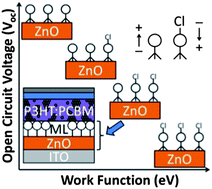Tuning zinc oxide/organic energy level alignment using mixed triethoxysilane monolayers†
Abstract
Interfacial energy level alignment influences several critical organic optoelectronic device characteristics including charge transfer barriers, turn-on voltage, and open circuit voltage (Voc). Introduction of dipolar molecular monolayers on metal


 Please wait while we load your content...
Please wait while we load your content...